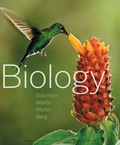
Concept explainers
Introduction: Normally each cell in humans has 46 chromosomes (23 pairs). Twenty-two pairs of chromosomes are autosomes and one pair is sex chromosome (X and Y). Any variations in chromosomal arrangements leading to defects can be identified by karyotyping, pedigree analysis, and DNA sequencing.
Answer to Problem 1TYU
Correct answer: A diagram of pedigree shows the expression of genetic traits in the members of two or more generations of a family. Hence, the correct answer is Option (e).
Explanation of Solution
Reason for the correct answer:
Option (e) is given as “the expression of genetic traits in the members of two or more generations of a family”. Pedigree represents the genetic family history to determine the risk or presence of a disease in the next generation. It is referred as a family tree that is drawn by tracing the history of variant
Hence, the correct answer is Option (e).
Reasons for incorrect answers:
Option (a) is given as, “controlled matings between members of different true-breeding strains”. This is referred as a monohybrid cross. Hence, Option (a) is incorrect.
Option (b) is given as, “the total genetic information in human cells”. Chromosomes, genes, and DNA constitute the total genetic information. A pedigree is formed based on the phenotypic variations in a gene or an organism from one generation to next generations. Hence, Option (b) is incorrect.
Option (c) is given as, “a comparison of DNA sequences among the genomes of humans and other species”. This is referred as a study of comparative genomics. A pedigree does not compare the genomes of different species. Hence, Option (c) is incorrect.
Option (d) is given as, “the subtle genetic differences among unrelated people”. A pedigree is formed based on the phenotypic variations in a gene or an organism from one generation to next generations. It does not relate to genotypic variations. Hence, Option (d) is incorrect.
Hence, Options (a), (b), (c), and (d) are incorrect.
A pedigree shows the expression of genetic traits among two or more generations of a family.
Want to see more full solutions like this?
Chapter 16 Solutions
EBK BIOLOGY
- Outline the negative feedback loop that allows us to maintain a healthy water concentration in our blood. You may use diagram if you wisharrow_forwardGive examples of fat soluble and non-fat soluble hormonesarrow_forwardJust click view full document and register so you can see the whole document. how do i access this. following from the previous question; https://www.bartleby.com/questions-and-answers/hi-hi-with-this-unit-assessment-psy4406-tp4-report-assessment-material-case-stydu-ms-alecia-moore.-o/5e09906a-5101-4297-a8f7-49449b0bb5a7. on Google this image comes up and i have signed/ payed for the service and unable to access the full document. are you able to copy and past to this response. please see the screenshot from google page. unfortunality its not allowing me attch the image can you please show me the mathmetic calculation/ workout for the reult sectionarrow_forward
- Skryf n kortkuns van die Egyptians pyramids vertel ñ story. Maximum 500 woordearrow_forward1.)What cross will result in half homozygous dominant offspring and half heterozygous offspring? 2.) What cross will result in all heterozygous offspring?arrow_forward1.Steroids like testosterone and estrogen are nonpolar and large (~18 carbons). Steroids diffuse through membranes without transporters. Compare and contrast the remaining substances and circle the three substances that can diffuse through a membrane the fastest, without a transporter. Put a square around the other substance that can also diffuse through a membrane (1000x slower but also without a transporter). Molecule Steroid H+ CO₂ Glucose (C6H12O6) H₂O Na+ N₂ Size (Small/Big) Big Nonpolar/Polar/ Nonpolar lonizedarrow_forward
- what are the answer from the bookarrow_forwardwhat is lung cancer why plants removes liquid water intead water vapoursarrow_forward*Example 2: Tracing the path of an autosomal dominant trait Trait: Neurofibromatosis Forms of the trait: The dominant form is neurofibromatosis, caused by the production of an abnormal form of the protein neurofibromin. Affected individuals show spots of abnormal skin pigmentation and non-cancerous tumors that can interfere with the nervous system and cause blindness. Some tumors can convert to a cancerous form. i The recessive form is a normal protein - in other words, no neurofibromatosis.moovi A typical pedigree for a family that carries neurofibromatosis is shown below. Note that carriers are not indicated with half-colored shapes in this chart. Use the letter "N" to indicate the dominant neurofibromatosis allele, and the letter "n" for the normal allele. Nn nn nn 2 nn Nn A 3 N-arrow_forward
 Biology (MindTap Course List)BiologyISBN:9781337392938Author:Eldra Solomon, Charles Martin, Diana W. Martin, Linda R. BergPublisher:Cengage Learning
Biology (MindTap Course List)BiologyISBN:9781337392938Author:Eldra Solomon, Charles Martin, Diana W. Martin, Linda R. BergPublisher:Cengage Learning Biology: The Dynamic Science (MindTap Course List)BiologyISBN:9781305389892Author:Peter J. Russell, Paul E. Hertz, Beverly McMillanPublisher:Cengage Learning
Biology: The Dynamic Science (MindTap Course List)BiologyISBN:9781305389892Author:Peter J. Russell, Paul E. Hertz, Beverly McMillanPublisher:Cengage Learning Biology 2eBiologyISBN:9781947172517Author:Matthew Douglas, Jung Choi, Mary Ann ClarkPublisher:OpenStax
Biology 2eBiologyISBN:9781947172517Author:Matthew Douglas, Jung Choi, Mary Ann ClarkPublisher:OpenStax Human Heredity: Principles and Issues (MindTap Co...BiologyISBN:9781305251052Author:Michael CummingsPublisher:Cengage Learning
Human Heredity: Principles and Issues (MindTap Co...BiologyISBN:9781305251052Author:Michael CummingsPublisher:Cengage Learning Biology Today and Tomorrow without Physiology (Mi...BiologyISBN:9781305117396Author:Cecie Starr, Christine Evers, Lisa StarrPublisher:Cengage Learning
Biology Today and Tomorrow without Physiology (Mi...BiologyISBN:9781305117396Author:Cecie Starr, Christine Evers, Lisa StarrPublisher:Cengage Learning




